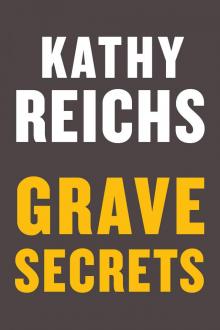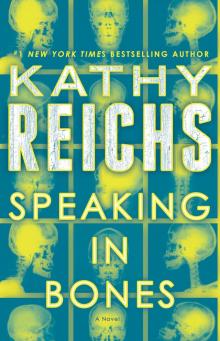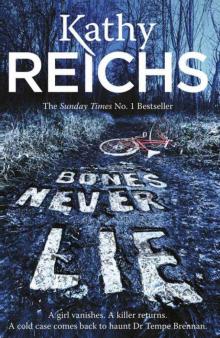- Home
- Kathy Reichs
Déjà Dead Page 4
Déjà Dead Read online
Page 4
“Monsieur Claudel,” I said without looking up. “Look at this.”
He came up behind me, and I moved over to allow him an unobstructed view. I pointed to an irregularity on the upper border of the hip. The iliac crest was in the process of attaching itself when death had occurred.
I set the pelvis down. He continued looking at it, but didn’t touch it. I returned to the body to examine the clavicle, certain of what I’d find. I withdrew the sternal end from the water and began to tease away the tissue. When I could see the joint surface I gestured for Claudel to join me. Wordlessly I pointed to the end of the bone. Its surface was billowy, like the pubic face. A small disk of bone clung to the center, its edges distinct and unfused.
“So?” Sweat beaded his forehead. He was hiding his nervousness with bravado.
“She’s young. Probably early twenties.”
I could have explained how bone reveals age, but I didn’t think he’d be a good listener, so I just waited. Particles of cartilage clung to my gloved hands, and I held them away from my body, palms up, like a panhandler. Claudel kept the same distance he would with an Ebola patient. His eyes stayed on me, but their focus shifted to thoughts inside his head as he ran through the data, looking for a match.
“Gagnon.” It was a statement, not a question.
I nodded. Isabelle Gagnon. Age twenty-three.
“I’ll have the coroner request dental records,” he said.
I nodded again. He seemed to bring it out in me.
“Cause of death?” he asked.
“Nothing apparent,” I said. “I may know more when I see the X rays. Or I may see something on the bones when they’re cleaned.”
With that he left. He didn’t say good-bye. I didn’t expect it. His departure was mutually appreciated.
I stripped off my gloves and tossed them. On the way out I poked my head into the large autopsy suite and told Daniel I was finished with this case for the day. I asked him to take full body and cranial X rays, A-P and lateral views. Upstairs I stopped by the histology lab and told the head technician that the body was ready for boiling, warning him to take extra care since this was a dismemberment. It was unnecessary. No one could reduce a body like Denis. In two days a skeleton would appear, clean and undamaged.
• • •
I spent the rest of the afternoon with the glued-together skull. Though fragmentary, there was, indeed, enough detail to confirm the identity of its owner. He wouldn’t drive any more propane tankers.
Returning home, I began to feel the sense of foreboding I’d experienced in the ravine. All day I’d used work to keep it at bay. I’d banished the apprehension by centering my mind fully on identifying the victim and on piecing together the late trucker. At lunch the park pigeons had been my distraction. Unraveling the pecking order could be all-consuming. Gray was alpha. Brown speckles seemed to be next. Blackfoot was clearly low on the list.
Now I was free to relax. To think. To worry. It started as soon as I pulled into the garage and turned off the radio. Music off, anxiety on. No, I admonished myself. Later. After dinner.
I entered the apartment and heard the reassuring beep of the security system. Leaving my briefcase in the entry hall, I closed the door and walked to the Lebanese restaurant on the corner, where I ordered a Shish Taouk and Shawarma plate to go. It’s what I love most about living downtown—within a block of my condo are representative samples of all the cuisines of the world. Could the weight gain …? Nah.
While I waited for the take-out I perused the buffet selections. Homos. Taboule. Feuilles de vignes. Bless the global village. Lebanese gone French.
A shelf to the left of the cash register held bottles of red wine. My weapon of choice. As I looked at them, for the thousandth time I felt the craving. I remembered the taste, the smell, the dry, tangy feel of the wine on my tongue. I remembered the warmth that would start in my gut and spread upward and outward, navigating a path through my body, lighting the fires of well-being along its course. The bonfires of control. Of vigor. Of invincibility. I could use that right now, I thought. Right. Who was I kidding? I wouldn’t stop there. What were those stages? I’d move right on to bulletproof and then to invisible. Or was it the other way around? No matter. I’d carry it too far, and then the crash would come. The comfort would be short term, the price heavy. It’d been six years since I’d had a drink.
I took my food home and ate it with Birdie and the Montreal Expos. He slept, curled in my lap, purring softly. They lost to the Cubs by two runs. Neither mentioned the murder. I appreciated that.
I took a long, hot bath and fell into bed at ten-thirty. Alone in the dark and quiet I could no longer suppress the thought. Like cells gone mad, it grew and gathered strength, finally forcing itself into my consciousness, insisting on recognition. The other homicide. The other young woman who’d come to the morgue in pieces. I saw her in vivid detail, remembered my feelings as I’d worked on her bones. Chantale Trottier. Age: sixteen. Strangled, beaten, decapitated, dismembered. Less than a year ago she’d arrived naked and packaged in plastic garbage bags.
I was ready to end the day but my mind refused to clock out. I lay there as mountains formed and the continental plates shifted. Finally, I fell asleep, the phrase ricocheting in my skull. It would haunt me all weekend. Serial murder.
GABBY WAS CALLING MY FLIGHT. I HAD AN ENORMOUS SUITCASE and couldn’t maneuver it down the jetway. The other passengers were annoyed, but no one was helping me. I could see Katy leaning out to watch me from the front row of first class. She was wearing the dress we’d chosen for her high school graduation. Moss green silk. But she’d told me later she didn’t like it, regretted the choice. She would’ve preferred the floral print. Why was she wearing it? Why was Gabby at the airport when she should have been at the university? Her voice over the loudspeaker was becoming louder, more strident.
I sat up. It was seven-twenty. Monday morning. Light illuminated the edges of the window shade, but little seeped into the room.
Gabby’s voice continued. “… but I knew I wouldn’t be able to get ya later. Guess you’re an earlier riser than I thought. Anyway, about to …”
I picked up the phone. “Hello.” I tried to sound less groggy than I was. The voice stopped in midsentence.
“Temp? Is that you?”
I nodded.
“Did I wake ya?”
“Yes.” I was not yet up to a witty response.
“Sorry. Should I call back later?”
“No, no. I’m up.” I resisted adding that I’d had to get up to answer the phone anyway.
“Butt outa bed, babe. Early worm time. Listen, about tonight. Could we make it se—” A high-pitched screech interrupted her.
“Hang on. I must’ve left the answering machine on automatic.” I set down the receiver and walked to the living room. The red light was flashing. I picked up the portable handset, returned to the bedroom, and replaced that receiver in its cradle.
“Okay.” By now I was fully awake and starting to crave coffee. I headed for the kitchen.
“I was calling about tonight.” Her voice had an edge to it. I couldn’t blame her. She’d been trying to finish one sentence for five minutes now.
“I’m sorry, Gabby. I spent the whole weekend reading a student thesis, and I was up pretty late last night. I was really sound asleep. I didn’t even hear the phone ring.” That was odd, even for me. “What’s up?”
“About tonight. Uh, could we make it seven-thirty instead of seven? This project has me jumpier than a cricket in a lizard cage.”
“Sure. No problem. That’s probably better for me too.” Cradling the phone on my shoulder, I reached into the cabinet for the jar of coffee beans, and transferred three scoops to the grinder.
“Want me to pick ya up?” she asked.
“Either way. I can drive if you want. Where should we go?” I considered grinding, decided against it. She already sounded a little touchy.
Silence. I could picture her pl
aying with her nose ring as she thought it over. Or today it might be a stud. At first it had bothered me, and I’d had difficulty concentrating in conversations with Gabby. I’d find myself focusing on the ring, wondering how much pain was involved in piercing one’s nose. I no longer noticed.
“It should be nice tonight,” she said. “How ’bout someplace we can eat outside? Prince Arthur or St. Denis?”
“Great,” I said. “No reason for you to come down here, then. I’ll be by about seven-thirty. Think of someplace new. I feel like something exotic.”
Though it could be risky with Gabby, that was our usual routine. She knew the city much better than I, so the choice of restaurant usually fell to her.
“Okay. À plus tard.”
“À plus tard,” I responded. I was surprised and a bit relieved. Normally she’d stay on the phone forever. I often had to manufacture excuses to escape.
The telephone has always been a lifeline for Gabby and me. I associate her with the phone as I do no one else. This pattern was set early in our friendship. Our graduate student conversations were a strange relief from the melancholy that enveloped me in those years. My daughter Katy finally fed, bathed, and in her crib, Gabby and I would log hours on the line, sharing the excitement of a newly discovered book, discussing our classes, professors, fellow students, and nothing in particular. It was the only frivolity we allowed ourselves in a nonfrivolous time in our lives.
Though we talk less frequently now, the pattern has altered little in the decades since. Together or apart, we are there for each other’s highs and lows. It was Gabby who talked me through the AA days, when need for a drink colored my waking hours and brought me to at night, trembling and sweating. It is me whom Gabby dials, exhilarated and hopeful when love enters her life, lonely and despairing when, once again, it leaves.
When the coffee was ready I took it to the glass table in the dining room. Memories of Gabby were replaying in my mind. I always smiled when I thought of her. Gabby in grad seminar. Gabby at the Pit. Gabby at the dig, red kerchief askew, hennaed dreadlocks swinging as she scraped the dirt with her trowel. At six foot one she understood early that she’d never be a conventional beauty. She didn’t try to become thin or tan. She didn’t shave her legs or armpits. Gabby was Gabby. Gabrielle Macaulay from Trois-Rivières, Quebec. French mother, English father.
We’d been close in grad school. She’d hated physical anthropology, suffered through the courses I loved. I felt the same about her ethnology seminars. When we left Northwestern I’d gone to North Carolina and she’d returned to Quebec. We’d seen little of each other over the years, but the phone had kept us close. It was largely because of Gabby that I’d been offered a visiting professorship at McGill in 1990. During that year I’d begun working at the lab part time, and had continued the arrangement after returning to North Carolina, commuting North every six weeks as the caseload dictated. This year I had taken a leave of absence from UNC-Charlotte, and was in Montreal full time. I’d missed being with Gabby, and was enjoying the renewal of our friendship.
The flashing light on the answering machine caught my eye. There must’ve been a call before Gabby. I had it set to answer after four rings unless the tape had already been triggered. Then it would pick up after one. Wondering how I could’ve slept through four rings and an entire message, I went over and pressed the button. The tape rewound, engaged, and played. Silence, then a click. A short beep followed, then Gabby’s voice. It was only a hang-up. Good. I hit rewind and went to dress for work.
• • •
The medico-legal lab is located in what is known as the QPP or SQ building, depending on your linguistic preference. To anglophones, it is the Quebec Provincial Police—to francophones, La Sûreté du Québec. The Laboratoire de Médecine Légale, similar to a medical examiner’s office in the States, shares the fifth floor with the Laboratoire des Sciences Judiciaires, the central crime lab for the province. Together the LML and the LSJ make up a unit known as La Direction de l’Expertise Judiciaire—DEJ. There is a jail on the fourth and top three floors of the building. The morgue and autopsy suites are in the basement. The provincial police occupy the remaining eight floors.
This arrangement has its advantages. We’re all together. If I need an opinion on fibers, or a report on a soil sample, a walk down the corridor takes me directly to the source. It also has its drawbacks in that we are easily accessible. For an SQ investigator, or a city detective dropping off evidence or paperwork, it is a short elevator ride to our offices.
Witness that morning. Claudel was waiting at my office door when I arrived. He was carrying a small brown envelope and repeatedly tapped its edge against the palm of his hand. To say he looked agitated would be like saying Gandhi looked hungry.
“I have the dental records,” he said in way of greeting. He flourished the envelope like a presenter at the Academy Awards.
“I picked them up myself.”
He read a name scrawled on the outside. “Dr. Nguyen. He’s got an office over in Rosemont. I would have been here earlier but the guy’s got a real cretin of a secretary.”
“Coffee?” I asked. Though I’d never met Dr. Nguyen’s secretary I felt empathy for her. I knew she hadn’t had a good morning.
He opened his mouth to accept or decline. I don’t know which. At that moment Marc Bergeron rounded the corner. Seemingly unaware of our presence, he strode past the row of shiny black office doors, stopping one short of mine. Crooking a knee, he placed his briefcase on the upraised thigh. I thought of the crane maneuver in the Karate Kid. Thus poised, he clicked the case open, rummaged among its contents, and withdrew a set of keys.
“Marc?”
It startled him. He slammed the case shut and swung it down, all in one movement.
“Bien fait,” I said, suppressing a smile.
“Merci.” He looked at Claudel and me, the briefcase in his left hand, the keys in his right.
Marc Bergeron was, by any standard, peculiar-looking. In his late fifties or early sixties, his long, bony frame was slightly stooped, bent forward at midchest as if perpetually ready to absorb a blow to the stomach. His hair started midway back on his scalp and exploded in a corona of white frizz. It brought him to well over six foot three. His wire-rimmed glasses were always greasy and speckled with dust, and he often squinted, as though reading the fine print on a rebate coupon. He looked more like a Tim Burton creation than a forensic dentist.
“Monsieur Claudel has the dental records for Gagnon,” I said, indicating the detective. Claudel raised the envelope, as if in proof.
Nothing clicked behind the smudged lenses. Bergeron regarded me blankly. He looked like a tall, confused dandelion, with his long, thin stem and puff of white hair. I realized he knew nothing about the case.
Bergeron was among the professionals employed part time by the LML, each a forensic specialist consulted for specific expertise. Neuropathology. Radiology. Microbiology. Odontology. He normally came to the lab once a week. The rest of the time he saw patients in private practice. He hadn’t been here last week.
I summarized. “Last Thursday workers found some bones on the grounds of Le Grand Séminaire. Pierre LaManche thought it was another historic cemetery situation and sent me over. It wasn’t.”
He set down the briefcase and listened intently.
“I found parts of a dismembered body that had been bagged and dumped, probably within the last couple of months. It’s a female, white, probably in her early twenties.”
Claudel’s envelope tapping had become more rapid. It stopped momentarily as he looked pointedly at his watch. He cleared his throat.
Bergeron looked at him, then back at me. I continued.
“Monsieur Claudel and I narrowed the possibles to one we think is pretty good. The profile fits and the timing is reasonable. He drove the records in himself. A Dr. Nguyen over in Rosemont. Know him?”
Bergeron shook his head and extended a long, skinny hand. “Bon,” he said. “Give them to
me. I’ll have a look at them. Has Denis done X rays yet?”
“Daniel did them,” I said. “They should be on your desk.”
He unlocked the door to his office. Claudel followed. Through the open door I could see a small brown envelope lying on his desk. Bergeron picked it up and checked the case number. From where I stood I could see Claudel charting the room, like a monarch, deciding on a place to light.
“You may call me in an hour, Monsieur Claudel,” Bergeron said.
The detective stopped in mid-chart. He started to speak, then pressed his lips into a thin, tight line, readjusted his cuffs, and left. For the second time in minutes I suppressed a smile. Bergeron would never tolerate an investigator peering over his shoulder as he worked. Claudel had just learned that.
Bergeron’s gaunt face reappeared. “Coming in?” he asked.
“Sure,” I said. “Coffee?” I still hadn’t had any since getting to work. We often got it for each other, taking turns making the trek to the kitchenette in the other wing.
“Great.” He dug out his mug and handed it to me. “I’ll get set up here.”
I got my own mug and started down the corridor. I was pleased at his invitation. We often worked the same cases, the decomposed, burned, mummified, or skeletonized, the dead who could not be identified by normal means. I thought we worked well together. It seemed he agreed.
When I returned, two sets of small black squares lay on the light box. Each X ray showed a segment of jaw, the dentition bright against a stark black background. I remembered the teeth as I’d first seen them in the woods, their flawlessness in sharp contrast to the grisly context. They looked different now. Sanitized. Neatly lined up in rows, ready for inspection. The familiar shapes of crowns, roots, and pulp chambers were illuminated in differing intensities of gray and white.
Bergeron began by arranging the antemortem radiographs to the right and the postmortem to the left. His long, bony fingers located a small bump on each X ray, and, one by one, he oriented them, placing the dot face up. When he’d finished, each antemortem radiograph lay in identical alignment to its postmortem counterpart.

 Two Nights
Two Nights The Bone Collection: Four Novellas
The Bone Collection: Four Novellas Fatal Voyage
Fatal Voyage 206 Bones
206 Bones Bones to Ashes
Bones to Ashes Terminal
Terminal Monday Mourning
Monday Mourning Flash and Bones
Flash and Bones Cross Bones
Cross Bones Devil Bones
Devil Bones Break No Bones
Break No Bones Swamp Bones
Swamp Bones Déjà Dead
Déjà Dead Shock
Shock Spider Bones
Spider Bones Death Du Jour
Death Du Jour Grave Secrets
Grave Secrets Trace Evidence: A Virals Short Story Collection
Trace Evidence: A Virals Short Story Collection Bones on Ice
Bones on Ice The Bone Code
The Bone Code Bones in Her Pocket
Bones in Her Pocket Seizure:
Seizure: Speaking in Bones
Speaking in Bones Deadly Decisions
Deadly Decisions Spike
Spike Bones Never Lie
Bones Never Lie Bones of the Lost
Bones of the Lost Virals 03.5 - Swipe
Virals 03.5 - Swipe Exposure
Exposure A Conspiracy of Bones
A Conspiracy of Bones Shift (tory brennan)
Shift (tory brennan) Bones of the Lost: A Temperance Brennan Novel tb-16
Bones of the Lost: A Temperance Brennan Novel tb-16 Virals tb-1
Virals tb-1 Bones Are Forever tb-15
Bones Are Forever tb-15 Code tb-3
Code tb-3 Seizure tb-2
Seizure tb-2 Deadly Descisions
Deadly Descisions Spider Bones: A Novel
Spider Bones: A Novel